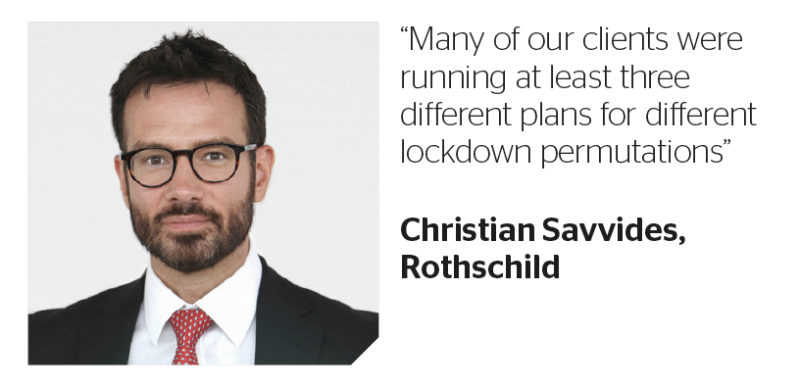“I don’t think we’ve ever seen this level of demand from companies needing advice on real and potential financing issues,” says Christian Savvides, co-head of debt advisory at Rothschild. “Even in the crisis of 2008/09, it was more spread out. In March 2020 most companies in the world were simultaneously wrestling with the implications of a fundamental and unprecedented change in the business environment. But I think the lasting impact of Covid-19 may mean 2021 is just as busy.”
The Covid crisis upended the corporate credit landscape. Many businesses, in travel and tourism, leisure and gaming, retail and real estate, have seen revenues disappear for large chunks of the year, and, in many cases, they may not return, even in a post-vaccine world. Working from home and ordering online may be a permanent hit to corporate landlords, retailers and conference producers.
Covid-19 is a disease that hits hardest for those with pre-existing conditions, and the same goes for companies. Firms creaking under their debt loads before March 2020 had to move particularly swiftly to have any hope of staying solvent through the crisis.

“Lenders bracketed issuers into those who required liquidity or covenant relief to bridge over the collapse in output, and those that were going into this collapse with balance sheets already under considerable stress,” says Alex Vavalidis, managing director in restructuring at Goldman Sachs. “If you look at the first wave of restructurings that have happened this year, most came as a result of this crisis affecting those companies already most vulnerable.”
The pandemic meant some of the traditional tools of corporate finance made little sense. What’s the point of a debt to Ebitda ratio over the last 12 months if half of that time was spent deep in a global pandemic?
But nonetheless, management teams, banks and investors had to do something — and the first step was to figure out just how bad things could be.
“As soon as the crisis hit Europe, companies and sponsors began adjusting their business models and scenario planning,” says Savvides. “Many of our clients were running at least three different plans for different lockdown permutations.”
First, survive
But for all companies, the first step was ensuring survival. The first part of the pandemic looked remarkably similar across leveraged and investment grade corporates alike — companies hoarded cash wherever possible. This meant precautionary drawings on their revolving credit facilities, applying for state funds and support, plus extensive operational changes like furloughing workers and mothballing ships and planes.

Looking further down the line, many firms realised that the June 2020 covenant test date would be crucial. With much of Q2 spent in lockdowns, many companies were staring at a potential default on most of their borrowing, just over three months after the pandemic swept across Europe and the US — and this needed swift action.
The almost-universal result that lenders waived the June test, and often several quarters afterwards. No banks or institutional lenders wanted to take the keys to a potentially viable business, or force the sale of a no-revenue Covid-addled company while the pandemic still raged.
“Lenders behaved very rationally, and gave companies a lot of room, recognising that the scenario playing out was not their fault, and to turn off liquidity was an issue of survival for some companies,” says Mike Marsh, head of EMEA credit finance at Goldman Sachs. “It might not have been logical from credit-first principles, but I think banks generally gave companies ample leeway.”
But the waivers often came with conditions. In some cases, banks granted multiple quarters of covenant relief with little fuss. For the most stressed companies, though, they wanted other creditors to take some pain, or equity backers to put in new cash.
“The typical equity ask wasn’t a full turn of Ebitda let alone anything greater,” says Jeremy Duffy, leveraged finance partner at White & Case. “The purpose was usually for sponsors to share the pain and show commitment to the business.”
Most crucial, for lenders, was more information.
“Lenders’ objective was to get under the hood of some of these businesses, which meant not only a minimum liquidity covenant tested monthly, but also information rights including the provision of a monthly management call and management accounts in agreed format each month,” says Duffy.
“The package certainly wasn’t a slam dunk concession which companies were always happy to grant. Some lenders also requested a board seat or shadow board seat, which wasn’t always well received.”
I’m from the government, and I’m here to help
Many companies also applied for various government help schemes which were on offer — but their success varied drastically by jurisdiction.
In the UK, large loans weren’t available with government guarantee at first, and throughout Europe, rules on shareholder loans made it painful for private equity-backed companies to take advantage. Nearly everywhere, government schemes attempted to limit moral hazard, giving a partial guarantee for 70%-90% of loans, for example.
But this just limited access to the schemes for the most challenged companies. A bank that thought it would lose €50m lending to a struggling retailer wouldn’t suddenly lend to them because it would only lose €5m.
After the initial shockwave had passed and capital markets came back, corporate options multiplied for the creditworthy. Many did rights issues, or termed out their emergency funding. Banks pushed others to pay down their revolvers with asset-based facilities or bond finance.
“It does feel as though a lot of the short term liquidity that had been raised has already been repaid, and if it hasn’t, it should roll off next year, unless there are some underlying corporate issues,” says Marsh.
But despite the strength of the rally, for those that needed it most, markets stayed shut.
“We’ve effectively got two separate leveraged finance markets right now,” says Savvides. “The market experience of a borrower in healthcare, tech or food is entirely unrecognisable to a borrower in high street retail, leisure or travel and tourism. Some issuers are achieving leverage and pricing not far off pre-Covid levels, while others are simply unable to come to market at all.”
The most desperate companies had other levers available, but pulling them could be a one-way process. Companies could optimise working capital using receivables securitizations, but these rely on generating receivables in the first place, impossible for firms whose business was effectively shut.
That leaves paying suppliers late, or not paying at all. The latter, in the form of rent holidays or deferrals, was a popular option, with retailers in particular unwilling to pay landlords for shops that couldn’t open. But this just pushed the problem elsewhere, into the commercial property sector.
For companies that could come to the market, even on eye-watering terms, one priority was often paying off government loans, even when these were on preferential terms. Aston Martin paid more than 10% to refinance in November, using the cash to extinguish its CLBILS (Coronavirus Large Business Interruption Loan Scheme) funds from the UK government.
“Quite a few companies are now thinking about repaying or refinancing loans they obtained under the government schemes,” said Savvides. “Even if there is a cost premium, some borrowers want to move back to private market financing sooner rather than later — in some cases motivated by specific concerns such as dividend flexibility.”
Vital injection
As vaccine news sent markets soaring in November, this created another step change in market access. Not only were companies in challenged sectors able to come to market, they saw the strongest investor demand, as buyside firms scrambled for maximum exposure to the rally.
Gym chains, conference organizers, cruise companies and airlines flocked to market, eager, after a long hiatus, to raise cash from the market. That’s meant companies can avoid turning to the most expensive forms of capital, such as special situations funds offering bespoke senior financing.
“There’s a whole host of businesses that need capital, whether it’s the liquidity to the balance sheet or to take care of existing liabilities, and had the markets not been open in a way that they have been post-vaccine, they would have had to have gone to other alternative sources to find that capital,” says Vavalidis.
Raising cash against zero revenue means, unfortunately, that leverage multiples go up permanently. Companies that were struggling to deleverage before the pandemic cannot trade their way out of trouble, but will have to find another solution — and that will be the task for 2021.
Postponed reckoning
For some, this will mean debt restructuring. Restructuring groups at law firms and banks have already had a very busy year, but many of the deals struck in 2020 have simply postponed a reckoning, rather than created a sustainable capital structure.
“I think it’s expected that there will be some more zombie companies that become burning platforms, and aren’t able to be rescued,” says Duffy.
“However, given the vaccine programmes and hope for a general opening up next year, at the moment it appears that there’s a bit of positivity in the outlook. There’s an expectation that credits will continue to be able to access a liquid and open market if they can show a model encompassing the generation of sufficient cashflow once they’re again trading at full speed.”
Lenders and equity providers need some certainty on the speed and scale of any re-opening, to form the basis for a lasting rethink of corporate liabilities. For now, that’s obscure, and so for the most stressed firms, the song remains the same — keep hold of cash.
“Many of our clients are still keen to maintain the greatest amount of liquidity they can on the balance sheet as a buffer for any potential additional lockdowns or output collapses,” says Vavalidis. GC
